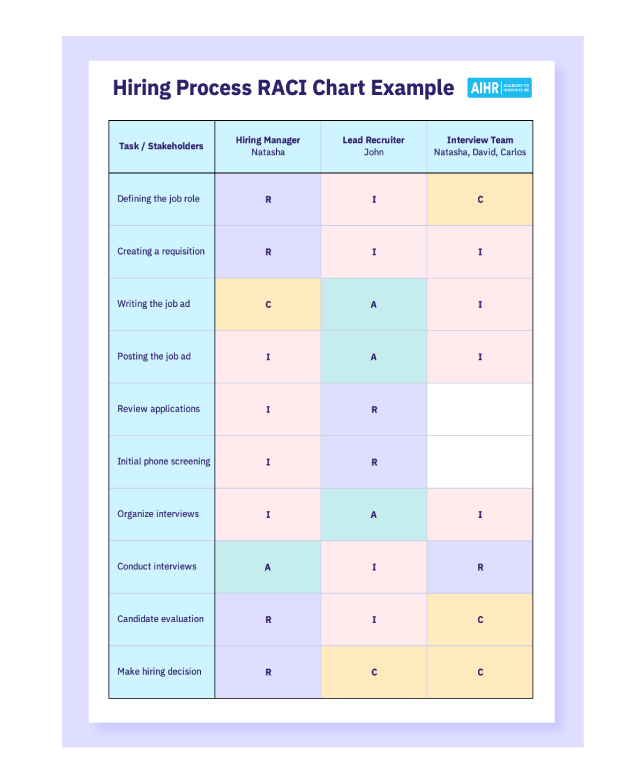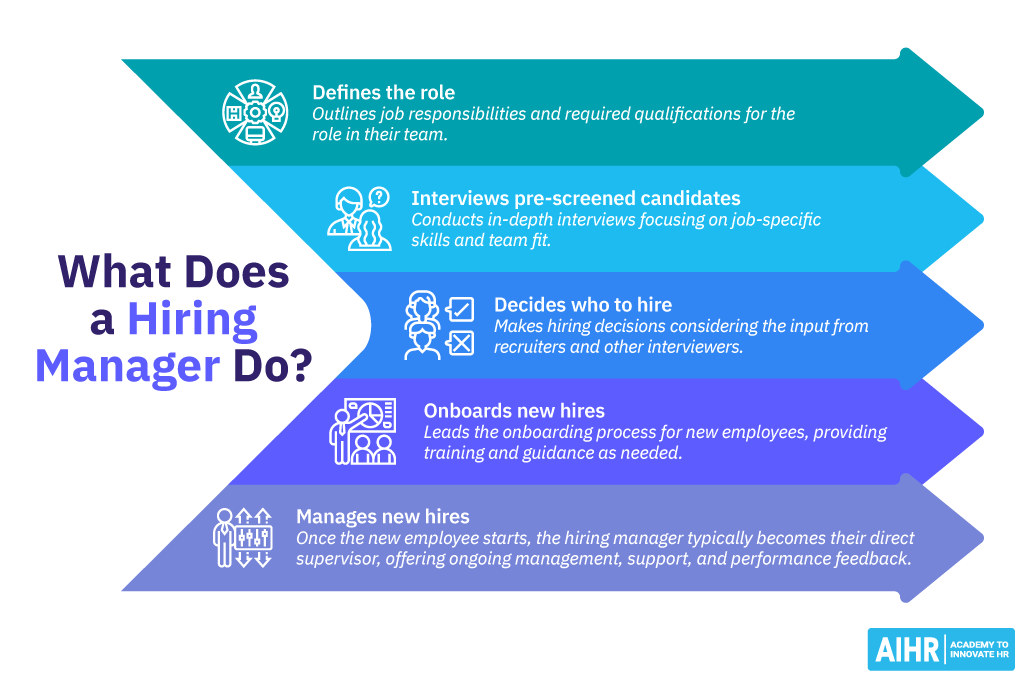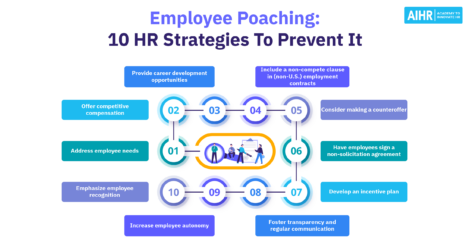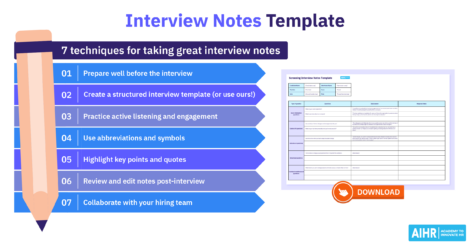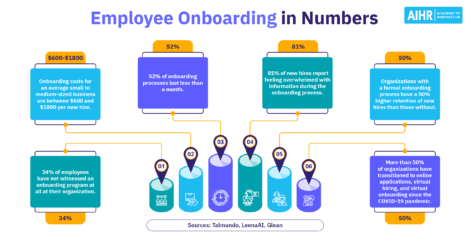Hiring Manager: All You Need To Know

The hiring manager is a key figure in any organization’s recruitment process. In this article, we’ll explore the role of the hiring manager, the difference between hiring managers and recruiters, why it is important to cultivate a strong relationship between the recruiter and hiring manager, and how to build one. Here goes!
Content
What is a hiring manager?
What does a hiring manager do?
Hiring manager vs. recruiter
Hiring manager vs HR
Why your organization needs a strong recruiter and hiring manager relationship
How to improve the recruiter and hiring manager relationship
Recruiter email template to hiring manager
FAQ
What is a hiring manager?
A hiring manager is a team leader who is involved in the hiring process to fill a vacancy in their department. In other words, they are the future manager of the new hire. A hiring manager initiates job requisitions, owns open positions, conducts interviews, makes the final decision on who to hire, and subsequently onboards the new employee.
The hiring manager can be any employee who runs a team or department, for example, Head of Sales in the Sales department or Store Manager in retail. In startups and smaller businesses, the hiring manager will often be the company’s CEO as there won’t be a lot of different teams yet.
The manager works together with the recruiter on hiring the new employee. The recruiter focuses on the operational and admin part of the process, while the hiring manager is the actual decision-maker.
What does a hiring manager do?
The hiring manager has numerous roles and responsibilities within the recruitment process. Let’s explore these in more detail.
Initiate the recruitment process
When there’s a need to fill a vacancy, the hiring manager must make a formal request to create a new position in the company in the form of a job requisition. They are usually also the ones completing the recruitment process when they decide which candidate gets hired.
Convey key information during the vacancy intake
Once the job requisition is approved, the recruiter sits down with the hiring manager to understand as much as possible about the vacant position.
The recruiter and the hiring manager need to clarify the following to start the recruitment process:
- What type of candidate is needed
- Skills, experience, and personality traits required
- What good performance looks like in this role
- The impact of a high performer on the team and organization
- Compensation and benefits this type of candidate will be looking for
- Weekly hours and paid overtime
- Budget for the position
The clearer information the recruiter gleans during the vacancy intake, the better the job description they will be able to draft. This, in turn, will have a positive impact on the fit of the candidates with both the job and the company culture.
Sharing the responsibility of tasks
In traditional recruitment models, the brunt of the recruitment process and workload rests on recruiters’ shoulders, which isn’t ideal for recruiters or hiring managers. It’s important to determine who will be responsible for what at the beginning of the process and make sure that everyone understands their role.
You can create a RACI matrix (Responsible – Accountable – Consulted – Informed) outlining the tasks to be carried out during the recruitment process, which can be helpful as a reference point for everyone involved. Here’s an example of what it could look like:
A book-summarizing subscription service company, Blinkist, created a recruitment operations model they called Decentralized Autonomous Hiring©. In this model, hiring managers share responsibilities during the hiring process with recruiters.
Recruiters act as “sparring partners,” and support, advise, and educate the hiring manager as and when needed, depending on how experienced they are. The result is a more efficient recruitment process that leads to an improved experience for all, including candidates.
Keeping in close contact with the recruiter
From the beginning to the end of the recruitment process, the manager is in close contact with the recruiter to understand the vacancy and the type of candidate needed to fill it. Depending on the size of the organization and whether or not you have an in-house recruitment team, this can be a freelance recruiter or someone from a specialized headhunting firm or agency.
Interviewing candidates
Once the recruiter has found a (selection of) potential candidates who have successfully gone through the company’s pre-selection rounds, the manager will conduct the technical and other in-depth interviews with them before a hiring decision is made.
Finding a candidate that fits and making the hiring decision
Hiring someone who brings experience, skills, or behavioral qualities to the table that the team currently lacks should be one of the hiring manager’s priorities while ensuring the candidate will gel well with the existing team.
Having interviewed and interviewed the shortlisted candidates, the hiring manager then makes the final decision on who to hire.
Onboarding and managing new hires
The hiring manager plays a key role in the employee onboarding process. They make sure newcomers feel right at home, integrate into the company culture, and are set up with everything they need to succeed in their new roles.
They act as the primary point of contact for new employees, addressing any concerns they might have. The hiring manager also continuously monitors and assesses the performance of new hires, providing feedback and guidance to foster their growth and development within the organization.
Learning and development
The hiring manager should have a clear idea of the direction in which they would like to see their team develop – based on the organization’s business goals – and what this means for each team member in terms of learning and development.
Having a team L&D strategy in place is a plus when interviewing candidates, as the hiring manager can share future development opportunities.
Other responsibilities
While responsibilities such as coaching, developing team members, and employee wellbeing are not directly linked to the hiring process, they do have an impact on how your organization is perceived by candidates and employees as an employer (i.e. your employer brand).
If your company is known for always putting its people first – for instance, through its peer coaching, mentoring, or employee wellness programs – this will positively affect your reputation among jobseekers. This, in turn, will make it easier to hire top candidates.
Hiring manager vs recruiter
Hiring managers are often confused with recruiters, and these terms are used interchangeably. However, these are two distinct roles.
Let’s recap the differences.
- The hiring manager is the future manager of the new hire. They initiate the hiring process, and interview, select, and onboard new employees. They are the final decision-maker and get to say who gets hired and who doesn’t. Hiring is just one part of their job of leading a team.
- The recruiter is a professional whose job is to promote vacancies and identify, attract, and (pre)select suitable candidates for specific roles. They’re part of the Recruitment, Talent Acquisition, or HR team.
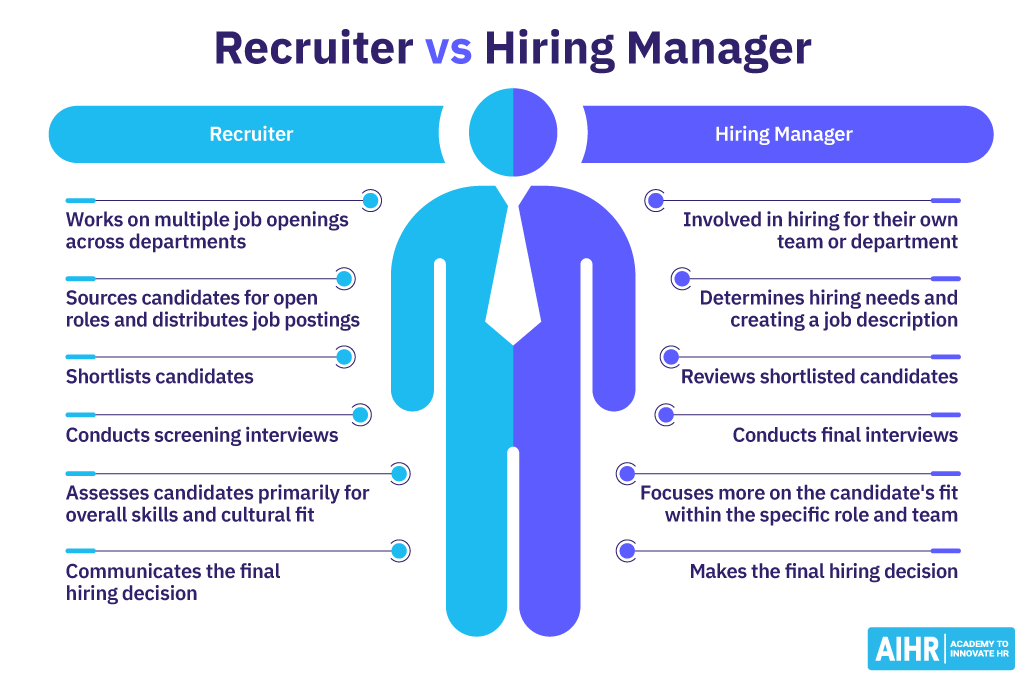
The fact that the hiring manager has the final decision power can sometimes cause tension between them and the recruiter. More often than not, managers tend to be in a rush when it comes to hiring new people into their team. Rather than patiently waiting for a full slate of candidates to interview, they’re eager to jump into interview mode as soon as the first people apply.
Recruiters, on the other hand, want to be able to properly assess candidates, follow the first steps of the recruitment process, and fill a slate before they present a selection of potential new hires to the hiring manager. Therefore, it is up to the recruiter to ‘manage’ the hiring manager and convince them not to rush things when it comes to interviewing (and hiring) a new employee.
Instead of it being the hiring manager vs. recruiter, think of these as two allies sitting at the same side of the table.
Hiring manager vs HR
Hiring managers are also commonly confused with Human Resources professionals because both can be involved in the recruitment process.
Put simply, HR is a team within an organization that, among other responsibilities, focuses on identifying new candidates, handling the admin side of recruitment and onboarding, supporting existing employees, overseeing learning and development, and dealing with grievances.
On the other hand, hiring managers identify staffing requirements within their teams, obtain recruitment approvals (if needed), write detailed job descriptions to send to HR, are often the point of contact during the interview process, lead the in-depth interviews with candidates, and make the final hiring decision.
Why your organization needs a strong recruiter and hiring manager relationship
As we’ve already mentioned, hiring managers and recruiters often have competing priorities – the need to hire someone as quickly as possible on one hand and following a systematic selection process on the other.
A strong recruiter and hiring manager relationship is essential to ensure that each person knows their responsibilities, the recruitment process is seamless for everyone involved, and the right candidate is hired for the right role.
A study by Bersin by Deloitte Consulting LLP found the biggest driver to a stronger talent acquisition department was “developing strong relationships with hiring managers.” Here’s why this relationship is so crucial:
- Effective and efficient hiring process – Recruiters and hiring managers both play a vital role in delivering an effective hiring process and working together is essential for speed and efficiency as well as quality.
- Improved quality of candidates – The stronger the relationship and understanding between the hiring manager and recruiter, the better idea the recruiter will have of the ideal candidate profile and skills needed for a particular role, and the higher the chances are of attracting and hiring a top candidate who is a good fit for the team and company.
- Better candidate experience – A seamless hiring process is fast and effective and delivers a better experience for all candidates, whether they are hired or not. This helps retain top candidates and prevent them from being poached by competitors due to a lack of communication or long waiting times between the recruitment process stages.
- Decreased new hire turnover – If the recruiter and hiring manager are on the same page and understand the type of candidate needed to fill a role and who will ultimately fit best in the organization, this can lead to a better overall fit and a reduction in new hire turnover rates.
- Easier problem solving when issues arise – A strong working relationship also means that any challenges or issues that arise can be handled with ease and prevented from escalating into a larger problem.
How to improve the recruiter and hiring manager relationship
Now that you understand the importance of a strong working relationship between recruiter and hiring manager, here are some tips on how recruiters can strengthen this relationship:
1. Understand hiring managers’ needs
It’s important that the recruiter takes the time to fully understand the requirements of the role they’re hiring for and what the manager is looking for. This includes not only the skills and experience needed but also the team culture and dynamics.
Prepare for meetings with the hiring manager and have some questions ready to help you understand their needs.
2. Clarify roles and responsibilities
Hiring managers and recruiters should sit down and define who is responsible for what in the hiring process. It’s a joint task that will involve input from both parties, so make this clear. A RACI chart, as mentioned above, can be a great tool for this and provide clarity to all.
Reiterating the responsibilities throughout the recruiting process helps ensure everyone stays on the same page and knows what to do when.
3. Establish clear communication
Both parties must provide regular updates, communicate where they are in the process, what their challenges are, and what they might need assistance with. Both parties should know each other’s preferred method of contact, whether it’s email, Slack/Teams messages, video or phone calls, or texts.
4. Organize hiring manager training
The recruitment process can be overwhelming for hiring managers, especially for those who are new to leading and expanding teams. You can support them by providing them with information on what the process entails and what mistakes to avoid.
This can include interview training for hiring managers, unconscious bias training, and training on the legal aspects of hiring. Such training will benefit both sides, as it increases both your confidence in the process and interview quality.
Also, ensure that hiring managers know what’s happening in the world of talent and emerging trends. For example, you can prepare a short presentation on your recruitment data. This will help manage their expectations and understand their needs and options better.
5. Be proactive
Don’t wait for the hiring manager to come to you with requests or issues. Regularly check in with them, anticipate their needs, and offer help before they have to ask for it.
6. Conduct a hiring manager satisfaction survey
Prepare and send out a hiring manager satisfaction survey that asks how satisfied they are with the recruitment process. Ask what suggestions they have for how things can be improved.
Having the hiring manager answer these questions will help you improve not only the hiring process and quality of candidates but also your relationship with the hiring manager.
7. Follow up
After a new hire starts, follow up with the hiring manager to ensure that the person is fitting well in the team and the role. This shows that you care about the long-term success of the hiring process, not just filling the position.
If there are any concerns, work together to come up with potential solutions, as well as preventative action going forward.
Recruiter email template to hiring manager
Here’s a recruiting update template that a recruiter can send to a hiring manager during the hiring process to keep them updated. Feel free to copy and edit this as needed.
Subject line: Quick update on the status of [Job_title] position
Hi [Hiring Manager’s_name],
Hope you’re well.
Please find a brief recap on where we currently stand with hiring for the [Job_title] role:
Applications received: [e.g. 56]
Phone screening calls conducted: [e.g. 10]
Applicants we advanced to the in-person interview phase: [e.g. 3]
Interviews scheduled for next week: [e.g. 3]
Deadline for completing all interviews: [e.g. 12/09/2023]
Please find some additional notes on the qualified candidates:
[Candidate1_name]: Has 18 months experience in a similar role at a competitor, contacted one of our recruiters directly about an open position, so seems quite keen.
[Candidate2_name]: Is a recent graduate with no formal experience but some relevant internship experience. Very friendly in our phone conversation.
[Candidate3_name]: Has 6 months of experience in a similar role as well as experience working overseas, which I know you mentioned could be of benefit to the team.
Please find a more detailed review attached [attach file to email.]
Let me know if you have any questions or want to schedule a quick call or meeting to discuss ahead of our interviews.
Thank you,
[Recruiter_name]
[Recruiter_signature]
Wrapping up
The hiring manager’s role in the recruitment process is multifaceted – from initiating the process through leading interviews to making the hiring decision and onboarding the new employee.
A strong relationship between the hiring manager and recruiter helps make the hiring process effective and efficient. Recruiters who can build and maintain such relationships position the organization to recruit top-tier talent that resonates with its values and objectives.
FAQ
A hiring manager is a department head looking to fill a role on their team. They’re going to be the new employee’s manager. The hiring manager initiates a job requisition, works closely alongside the recruiter throughout the recruitment process, interviews candidates, decides who to hire for the role, and onboards the new hire.
Hiring managers are not part of HR. They’re part of their respective department. Together with the HR and/or recruitment team, they’re involved in the recruitment process but in different capacities.
While HR focuses on attracting candidates and taking care of the administrative tasks of recruitment and onboarding, the hiring manager requests to fill a vacancy, conducts interviews with shortlisted job applicants, and makes sure the best candidate fills the open role.
In an interview, a hiring manager asks questions to determine whether a candidate possesses the right skills, experience, knowledge and behavioral qualities to succeed in the role and fit into the team.
Weekly update
Stay up-to-date with the latest news, trends, and resources in HR
Learn more
Related articles
Are you ready for the future of HR?
Learn modern and relevant HR skills, online





